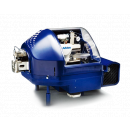应用领域:
资料类型:PDF
J Chromatogr B Analyt Technol Biomed Life Sci. 2009 Sep 15;877(26):2664-72. doi: 10.1016/j.jchromb.2009.02.037. Epub 2009 Feb 24. High-throughput shotgun lipidomics by quadrupole time-of-flight mass spectrometry. Ståhlman M1, Ejsing CS, Tarasov K, Perman J, Borén J, Ekroos K. Abstract
Technological advances in mass spectrometry and meticulous method development have produced several shotgun lipidomic approaches capable of characterizing lipid species by direct analysis of total lipid extracts. Shotgun lipidomics by hybrid quadrupole time-of-flight mass spectrometry allows the absolute quantification of hundreds of molecular glycerophospholipid species, glycerolipid species, sphingolipid species and sterol lipids. Future applications in clinical cohort studies demand detailed lipid molecule information and the application of high-throughput lipidomics platforms. In this review we describe a novel high-throughput shotgun lipidomic platform based on 96-well robot-assisted lipid extraction, automated sample infusion by mircofluidic-based nanoelectrospray ionization, and quantitative multiple precursor ion scanning analysis on a quadrupole time-of-flight mass spectrometer. Using this platform to compile comprehensive lipid arrays associated with metabolic dysfunctions is a powerful strategy for pinpointing the mechanistic details by which alterations in tissue-specific lipid metabolism are directly linked to the etiology of many lipid-mediated disorders.
2.2. Automated sample infusion by mircofluidic-based nanoelectrospray ionization Shotgun lipidomics has been successfully performed using nanoelectrospray ionization (nanoESI) [19,21]. Conventional nanoESI is sensitive and cost-effective, but requires manual loading of samples into small glass capillary emitters, manual positioning of emitters in front of the mass spectrometer orifice and adjustment of voltage and back pressure to achieve stable ion spray. Automation of nanoESI has been attempted by continuous flow injection for analysis of multiple samples [38]. Drawback of this technique is that all samples are infused through the same capillary emitter, which increases the risk for cross-contamination. An alternative is the automated chip-based nanoESI device: NanoMate TriVersa [39]. Here, the samples are aspirated robotically from a 96- or 384-well plate and infused into the mass spectrometer through separate nozzles on an ESI Chip. Each ESI Chip contains 400 nozzles. ESI Chips are available with nozzles having an inner diameter of 2.5, 4.1 or 5.0 m. The device eliminates cross-contamination between different samples and allows flow rates between 100 and 250 nL/min depending on ion spray parameters; e.g. nozzle diameter, ion spray voltage, back pressure and solvent composition.




